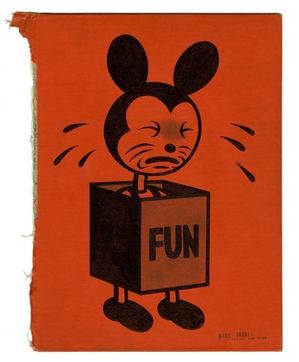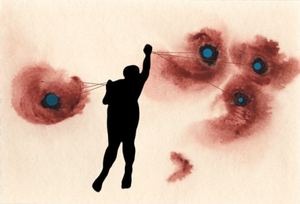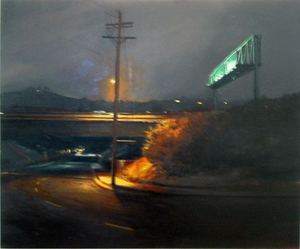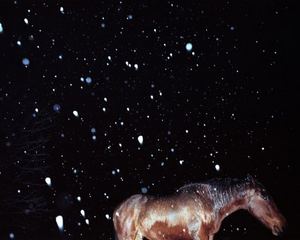Products are increasing available to take care of problems they don’t have. (Photo, Rooney O’Neil. Click to enlarge.)
Henry Wessel – road signs, continued
Alex Schweder & Ward Shelley: The leaky body in its portable house
In the first week of their exhibit at Lawrimore Project, Alex Schweder and Ward Shelley lived in their teeter-totter house, optimistically titled Stability.
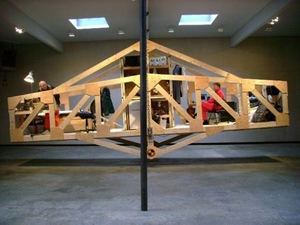 Even when otherwise engaged, they were intimately aware of each other’s weight. With a tilt and sway, each affected the other. Should they have wanted more intimate contact, they would have had to meet in the middle, like single beds braced for fusion.
Even when otherwise engaged, they were intimately aware of each other’s weight. With a tilt and sway, each affected the other. Should they have wanted more intimate contact, they would have had to meet in the middle, like single beds braced for fusion.
Maintaining their cheerfully weird fiction that they were comfortably kicking back at home, they lived like zoo animals. Naturally, visitors asked questions. Who wouldn’t want to hear what the monkey has to say? The most common query was obvious and frequent: Where do you go to the bathroom? (Check center spine for kitchen and toilet.)
Almost 40 years ago, when engagements of this sort broke new ground (among them, those of Joseph Beuys, Tehching Hsieh, David Hammons, Vito Acconci, Chris Burden, Kim Jones, Adrian Piper and Carolee Schneeman), artists tended to be more brutal with their persons. Who’d ask Kim Jones how he accomplished basic functions in his stick suit? The evidence of urine streaked the caked mud on his thighs.
There is less existential anguish in performance art today, and possibly more focused, conceptual intent. Schweder and Shelley explore the relationship between the housing and the housed.
I was out of town during the first week of Stability, but I don’t think I missed much. The piece itself is better off without the artists in it. It floats in space like a mirage. It’s the mytical room somewhere, a burrowing dream that surfaced in the air, the snail shell we long for but cannot possibly disappear into.
Asking Schweder where he pees makes sense, because his work is focused on body fluids. The long and honorable history of the urinal in art has never, to my knowledge, included actual urine, until now.
Below, Schweder. Plumbing Us, 2008. Virtreous china. 32 x 18 x 26 inches. Left
to right: front view of female urinal; side view showing shared wall;
detail of shared drain.
Edition of 3. The floor model is definitely in use.
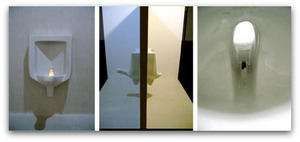 I love Schweder’s salute to Lawrence Weiner, Painting Instruction: Chair Exchange, 2009, Acrylic on canvas, Edition of 10. Each says, “Make your neighbor’s painting pinker.”
I love Schweder’s salute to Lawrence Weiner, Painting Instruction: Chair Exchange, 2009, Acrylic on canvas, Edition of 10. Each says, “Make your neighbor’s painting pinker.”
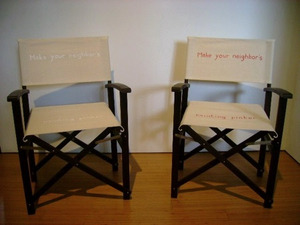 The dream of a room somewhere includes one enormous chair. Ms. Doolittle assumed the chair would hold its own under her weight, but Schewder’s version (a sofa, really) rides and fall with the movements of its occupants.
The dream of a room somewhere includes one enormous chair. Ms. Doolittle assumed the chair would hold its own under her weight, but Schewder’s version (a sofa, really) rides and fall with the movements of its occupants.
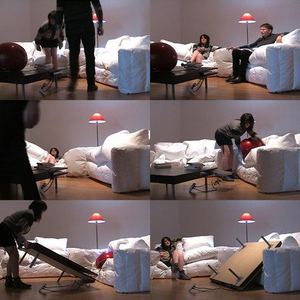 .
.
Through May 2. My review of Schweder’s A Sac of Rooms Three Times A Day here. Jen Graves here. Graves on Schweder receiving The Stranger’s 2007 Genius Award for visual art here.
Gary Taxali – Failing the Cat in Hat test
Look at me!
Look at me!
Look at me NOW!
It’s fun to have fun
But you have to know how!
Dr. Seuss, Cat in the Hat
Taxali at Jonathan LeVine Gallery till May 2.
Jenny Zoe Casey – Icarus continued
Why should I travel when I’m already there? Charioteer via artist’s Web site.
Art about money – the bottom rises to the top
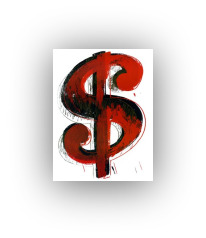 Following the worldwide crash, the heart has gone out of art about big money.
Following the worldwide crash, the heart has gone out of art about big money.
Once seen as the equivalent of a medical examiner performing an autopsy, For the Love of God has taken its rightful place as the corpse. With $20 million in rock candy glittering on its $100 million skull, it is more symptom than diagnosis. As such, the piece is a more powerful, less didactic work of art. A year ago, some dismissed it as a frivolous joke. Anybody laughing now? Certainly not the artist, whose chances of recouping his investment continue to dwindle.
Chris Burden’s One Ton One Kilo (100 kilos of gold) slipped between cup and lip. As he learned to his sorrow, his middleman being a Ponzi schemer, toying with the root of all evil has big bite-back potential.
Art about more common currencies continues to thrive. Too bad Cornelia Parker’s 30 Pieces of Silver isn’t on view. (Detail below) This is her moment – the betrayal inherent in consumerism finds its perfect expression in this piece. Her flattened objects may appear, like us, to be heading for the slag heap. Unlike us, however, they retain their allure.
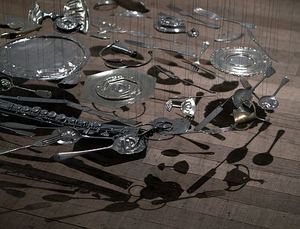 Nothing is more common than a penny. “The lowly penny,” said Jack Daws. “People don’t bend over to pick it up.”
Nothing is more common than a penny. “The lowly penny,” said Jack Daws. “People don’t bend over to pick it up.”
They would if they realized he’d made it. Daws fabricated 10 18-karat gold pennies and used one in a coffee shop at the Los Angeles airport. Each cost roughly $100 to make; Daws’ gallery, Greg Kucera, is selling the remainder for $1,000 each. The Treasury Department Secret Service takes a dim view of fake money in circulation, but Daws figures he’s safe, as his penny is value added, not detracted.
Other artists blurring the boundary between art and money include Gary Hill and JSB JSG Boggs.
Frank Ryan – road signs, continued
Frank Ryan, Overpass, oil/canvas, 40×48, 2008 (Click to enlarge)
Today Show fall guy – Kerry Skarbakka
You can pull all the stops out
Till they call the cops out
Grind your behind till you’re bent.
But you gotta get a gimmick
If you wanna get a hand.
You can sacrifice your sacharo
Working in the back row.
Bump in a dump till you’re dead.
Kid you gotta have a gimmick
If you wanna get ahead.
Stephen Sondheim, Gypsy
Visit msnbc.com for Breaking News, World News, and News about the Economy
Sam Falls – night moves
Sam Falls (Click to enlarge)
Tania Kitchell – every breath you take
Air Supply, 1-5, 2004 Images via Western Bridge from James Harris Gallery. (Click first four to enlarge)






